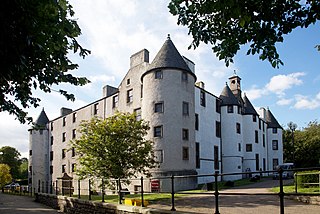
His Majesty's Advocate, known as the Lord Advocate, is the chief legal officer of the Scottish Government and the Crown in Scotland for both civil and criminal matters that fall within the devolved powers of the Scottish Parliament. They are the chief public prosecutor for Scotland and all prosecutions on indictment are conducted by the Crown Office and Procurator Fiscal Service in the Lord Advocate's name on behalf of the Monarch.

His Majesty's Solicitor General for Scotland is one of the Law Officers of the Crown, and the deputy of the Lord Advocate, whose duty is to advise the Scottish Government on Scots Law. They are also responsible for the Crown Office and Procurator Fiscal Service which together constitute the Criminal Prosecution Service in Scotland.

The Royal Company of Archers, The King's Bodyguard for Scotland, is a ceremonial unit that serves as the Sovereign's bodyguard in Scotland—a role it has performed since 1822 during the reign of King George IV when the company provided a personal bodyguard to the King on his visit to Scotland. It is currently known as the King's Bodyguard for Scotland or, more often and colloquially, The Royal Company. It is located in Edinburgh, the capital city of Scotland. The Royal Company of Archers has a long history in Scotland as a body that celebrated both the recreation and talent of local archers. As a body established by the Monarch, the company has a long history of unique prizes, influential supporters, and ceremonial roles. It has an associated charity, the Royal Company of Archers Charitable Trust, dedicated to helping disadvantaged individuals with their health and wellbeing in Scotland.
Sir James Sempill (1566–1626) was a Scottish courtier and diplomat.

The office of Keeper of the Privy Seal of Scotland, one of the Great Officers of State, first appears in the reign of David II. After the Act of Union 1707 its holder was normally a peer, like the Keeper of the Great Seal. The office has remained unfilled since the death of Gavin Campbell, 1st Marquess of Breadalbane in 1922.

Robert Kerr, 1st Earl of Ancram, was a Scottish nobleman, politician and writer.
Sir James Melville (1535–1617) was a Scottish diplomat and memoir writer, and father of the poet Elizabeth Melville.

George Gordon, 9th Marquess of Huntly,, styled Lord Strathavon until 1795 and known as The Earl of Aboyne from 1795 to 1836, was a Scottish peer and soldier.
Sir Lewis Bellenden of Auchnole and Broughton was a Scottish lawyer, who succeeded his father as Lord Justice Clerk on 15 March 1577.

James Hamilton of Bothwellhaugh and Woodhouselee was a Scottish supporter of Mary, Queen of Scots, who assassinated James Stewart, 1st Earl of Moray, Regent of Scotland, in January 1570. He shot Moray from the steps of his uncle Archbishop John Hamilton's house in Linlithgow.

Greyfriars Kirkyard is the graveyard surrounding Greyfriars Kirk in Edinburgh, Scotland. It is located at the southern edge of the Old Town, adjacent to George Heriot's School. Burials have been taking place since the late 16th century, and a number of notable Edinburgh residents are interred at Greyfriars. The Kirkyard is operated by City of Edinburgh Council in liaison with a charitable trust, which is linked to but separate from the church. The Kirkyard and its monuments are protected as a category A listed building.

Brooks's is a gentlemen's club in St James's Street, London. It is one of the oldest and most exclusive gentlemen's clubs in the world.
John Murray, 1st Earl of Annandale was a Scottish courtier and Member of Parliament.

James Scrimgeour Scottish landowner and Constable of Dundee.
Sir John Wishart of Pitarrow was a Scottish lawyer, courtier, comptroller of the exchequer, and rebel.
Sir Claud Hamilton of Shawfield, PC (Ire), also called of Leckprevick, a younger son of Claud Hamilton, 1st Lord Paisley in Scotland, was a gentleman of the privy chamber of King James VI and I, an undertaker in the Plantation of Ulster, and a privy counsellor in Ireland.









